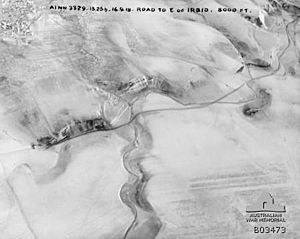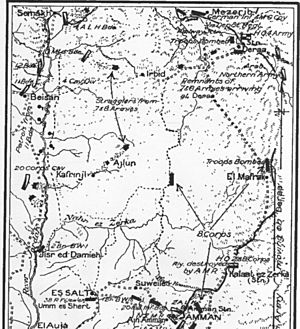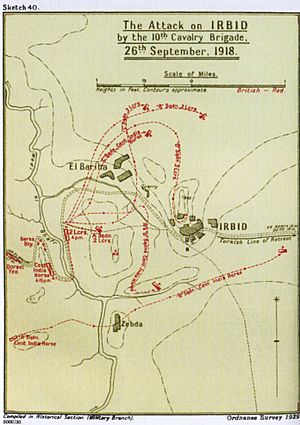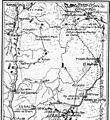Charge at Irbid facts for kids
Quick facts for kids Charge at Irbid |
|||||||
|---|---|---|---|---|---|---|---|
| Part of the Middle Eastern theatre of World War I | |||||||
 Aerial photograph of the road and wadi east of Irbid |
|||||||
|
|||||||
| Belligerents | |||||||
| Commanders and leaders | |||||||
| Units involved | |||||||
| 2nd Lancers Central India Horse 10th Cavalry Brigade 4th Cavalry Division Desert Mounted Corps Egyptian Expeditionary Force |
Remnants of the Fourth Army Yildirim Army Group |
||||||
The Charge at Irbid was a battle that happened on September 26, 1918, during World War I. It took place in the town of Irbid, which is now in modern-day Jordan. This event was part of a larger chase by the Desert Mounted Corps to capture Damascus after a big win at the Battle of Megiddo.
During the charge, a group of soldiers called the 2nd Lancers from the 10th Cavalry Brigade attacked the Ottoman Army soldiers defending Irbid. The Ottoman forces were retreating from other battles. The 2nd Lancers tried to charge, but the Ottoman soldiers fought back strongly and won this particular battle. However, the Ottoman forces left Irbid the next morning.
Contents
What Led to the Battle?
Ottoman Armies Retreat
After losing battles, the Ottoman armies, led by Otto Liman von Sanders, were trying to retreat. They were moving towards Damascus from different areas. One group, the Ottoman Fourth Army, was heading along a path called the Pilgrims' Road through Deraa.
Liman von Sanders arrived in Deraa on September 21. He ordered his Fourth Army to pull back to a line that included Irbid and Deraa. He also met with local leaders, who agreed to stay neutral in the conflict. Even though they were retreating, parts of the Fourth Army were still strong fighters.
British and Indian Forces Advance
The 4th Cavalry Division, which included British and Indian soldiers, had already captured important crossing points along the Jordan River. These included Afulah and Beisan. Their job was to block the retreating Ottoman forces.
On September 25, the Central India Horse joined the rest of the 10th Cavalry Brigade. They were ordered to quickly move to Irbid and Deraa. Their goal was to meet up with the Sherifial Army, which was an Arab force fighting alongside the British. The brigade started its advance towards Deraa on September 26.
The Battle of Irbid
Late in the afternoon of September 26, the 10th Cavalry Brigade faced strong Ottoman forces near Irbid. The 2nd Lancers were leading the attack. As they moved through a narrow valley west of Irbid, they came under heavy rifle fire.
The commander ordered an immediate attack. The 2nd Lancers tried a mounted charge, but it failed. They lost many soldiers because of the strong Ottoman defense.
- One squadron ("C" Squadron) got lost and didn't join the main attack.
- Another squadron ("B" Squadron) was stopped by machine gun fire.
- A third squadron ("D" Squadron), with only 48 soldiers, was heavily shot at by machine guns from Irbid. The ground was too rough for a proper charge. Only eight soldiers from "D" Squadron managed to retreat.
The British artillery, the Berkshire Battery, arrived too late to help the 2nd Lancers. Other units, like the Central India Horse, also tried to help but faced difficulties. By the time darkness fell, the fighting stopped. The 2nd Lancers and Central India Horse had 46 soldiers killed or wounded.
What Happened Next?
The Ottoman forces held their ground until it got dark. Then, during the night of September 26, they quietly left Irbid and moved to another town called Er Remte.
The next morning, September 27, patrols from the 2nd Lancers found Irbid empty. The Ottoman forces were gone.
One soldier, E. B. Maunsell, later wrote about seeing the dead horses from the fight at Irbid. He said that one squadron of the 2nd Lancers had a very tough time and lost more than half its soldiers.
This battle was the first time the 4th Cavalry Division had failed in an attack since September 19. It showed that rushing into battle without checking the area or knowing the enemy's strength could be very risky.
Meanwhile, Feisal's Arab forces, about 4,000 strong, marched overnight. They reached Sheikh Sa'd, north of Deraa, by dawn on September 27. They captured trains and many Ottoman prisoners. Fighting continued in Deraa, with more prisoners taken.
Between 6,000 and 7,000 German and Ottoman soldiers managed to retreat towards Damascus before the British and Arab forces captured Deraa and other areas.
Images for kids







